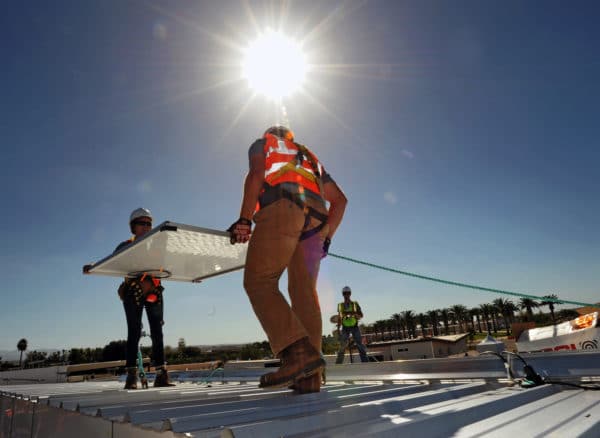Top executives of the nation’s public power providers are urging congressional leadership to support tax policies that allowing public power and electric cooperatives to fully make use of direct pay for renewable and clean energy tax credits.
Leaders of the American Public Power Association, National Rural Electric Cooperative Association, and Large Public Power Council wrote to top leaders in the House and Senate seeking what they say would be “comparable energy tax incentives” to support the deployment of clean energy technologies.
The executives said that much of the value of the tax credits flow to the project developers and their investors rather than to the not-for-profit utilities and their customers. In addition, to qualify for the credit, the project developer and tax-equity investors must retain ownership of the facility. Public utilities may only later buy the facilities by paying market prices for the facility.
“This increases the cost and inefficiency of the present system and means that the purchasing utility is denied the substantial operational benefits that flow from direct ownership,” the executives wrote.
They said that direct payments would be used to help offset project costs and increase the incentive for further investments, while enabling public power utilities and rural electric cooperatives to own clean energy facilities directly.
The three organizations represent public power utilities, which serve more than 49 million Americans, and rural electric cooperatives, which serve another 42 million.
Green hydrogen plant
Indiana-based Cummins and Iberdrola said they plan to build a $60 million, PEM electrolyzer plant in Castilla-La Mancha, Spain, to produce green hydrogen. The investment follows their earlier decision to partner on large-scale hydrogen production projects in Spain and Portugal.
A site selection search is currently underway for the plant, which will house system assembly and testing for roughly 500 MW/year and will be scalable to more than 1 GW/year. The facility is slated to open in 2023. Cummins has deployed more than 600 electrolyzers in 100 countries globally.
As part of the deal, a 230 MW green hydrogen project in Palos de la Frontera that Iberdrola has planned for fertilizer producer Fertiberia will become a benchmark for large electrolysis projects. Cummins will be the electrolyzer supplier for the Palos project. With experience gained in the project, Iberdrola and Cummins will work to design other large electrolysis projects. The two are also working on a hydrogen refueling station in Barcelona.
In Castilla-La Mancha, Iberdrola operates 2,376 MW of solar and wind energy. Recently, the company has completed three photovoltaic projects in the region, totaling 150 MW.
Coal power surges in early ’21
In the first four months of 2021, natural gas-fired generation in the Lower 48 states averaged 3,394 GWh per day, a nearly 7% decrease from the same period in 2020, according to data from the Energy Department’s Energy Information Administration (EIA). The drop stems from higher natural gas prices and increased competition from renewables, and is the first year-over-year decline since 2017.

Image: NREL/Dennis Schroeder
EIA said that natural gas-fired generation has faced increased competition from renewable generation because of recent record-high capacity additions to solar and wind power plants. Between May 2020 and February 2021, some 22.5 GW of combined net solar and wind additions came online, a 15% increase. EIA said that it expects another 28.7 GW of solar and wind capacity to enter service by the end of 2021.
By contrast, 4.8 GW of U.S. natural gas capacity came online between May 2020 and this past February, a 1% increase. EIA said it expects another 3.8 GW of natural gas capacity to come online through the end of the year.
U.S. natural gas prices have risen since April 2020 because of lower natural gas production and higher winter heating demand. Higher prices have made natural gas-fired generation relatively less competitive compared with coal-fired generation, prompting natural gas-to-coal fuel switching. EIA said that coal-fired generation rose nearly 40% during the first four months of 2021 compared with the same period in 2020, and accounts for 23% of total generation.
Aurora Solar closes finance round
Aurora Solar, which provides software for solar sales and project design, closed a $250 million Series C funding round led by Coatue, with follow-on participation from existing investors ICONIQ Capital, Energize Ventures, and Fifth Wall.
Over the past two years, Aurora Solar has raised more than $320 million. The company said it will use the investment to expand its product roadmap, hire more people, expand sales and customer support, and build its leadership team to scale the company.
This content is protected by copyright and may not be reused. If you want to cooperate with us and would like to reuse some of our content, please contact: editors@pv-magazine.com.









By submitting this form you agree to pv magazine using your data for the purposes of publishing your comment.
Your personal data will only be disclosed or otherwise transmitted to third parties for the purposes of spam filtering or if this is necessary for technical maintenance of the website. Any other transfer to third parties will not take place unless this is justified on the basis of applicable data protection regulations or if pv magazine is legally obliged to do so.
You may revoke this consent at any time with effect for the future, in which case your personal data will be deleted immediately. Otherwise, your data will be deleted if pv magazine has processed your request or the purpose of data storage is fulfilled.
Further information on data privacy can be found in our Data Protection Policy.